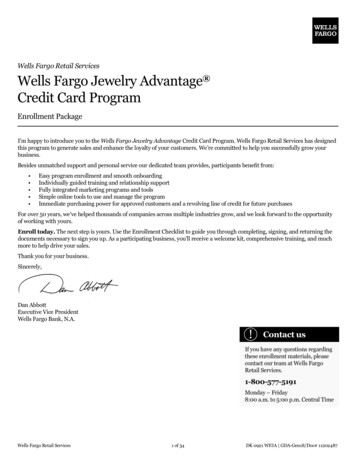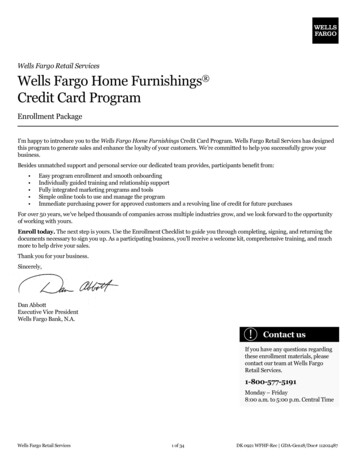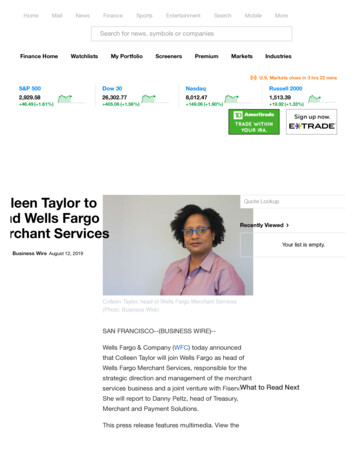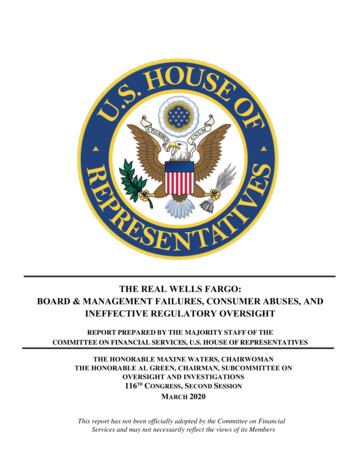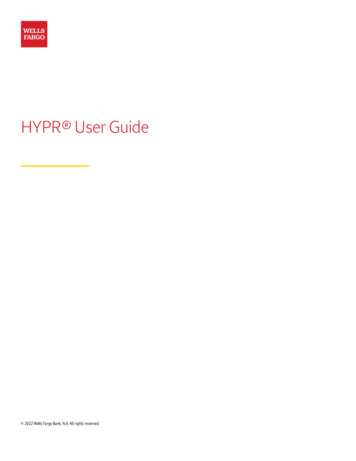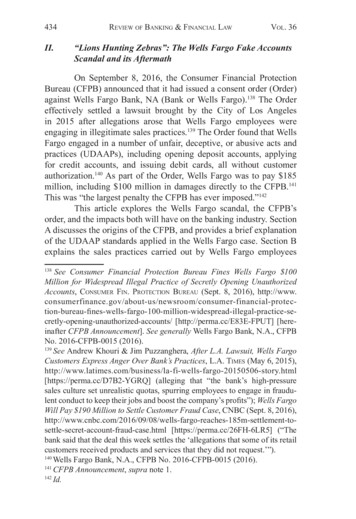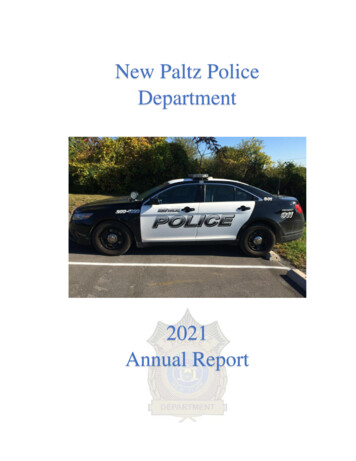
Transcription
WELLS FARGO420 MONTG OM ERY S T REE T S A N F R A N C I S C O, C A 94 1 0 41 866 8 7 8 5 8 6 5 W ELLS FA RG O.C OM 2022 Wells Fargo & Company. All rights reserved.Deposit products offered through Wells Fargo Bank, N.A. Member FDIC.CCM7565 (Rev 00, 1/each)WELL S FARGO & COMPANY ANNUAL REP ORTWELLS FARG O & COM PANY2021Annual Report Wells Fargo & Company
ContentsLetter from CEOIIOur PerformanceXVOperating CommitteeXVIBoard of DirectorsXVII2021 Financial Report1Stock Performance203About Wells Fargo204
A letter fromCharles W. ScharfCEO and PresidentWells Fargo & CompanyAs I write this letter refecting on 2021, it is difcultto describe what we have all been through and theextent to which COVID-19 has impacted the world.Over 400 million people have been infected with thevirus, almost 6 million people have died, and so manyothers have been impacted in diferent ways. At thesame time, we are learning to coexist with COVID-19.We now have multiple vaccines and a clearerunderstanding of how to protect ourselvesfrom infection.Wells Fargo has used its strength to provide supportthrough this crisis to our employees, customers, andcommunities, and we will continue to do so. We recognizethat the pandemic has left many people in need, andthat those needs haven’t gone away. As a company,we will continue to provide support to a diverse setof stakeholders over the long term.Alongside these eforts, the work we have been doingto transform Wells Fargo has made us an even strongercompany than we were a year ago. It has put us ina position to support a broad set of stakeholders,and it has positively impacted our results. While we stillhave much more to do, our foundation is stronger, ourbusiness is more focused, we are driving cultural change,the talent and management process changes we havemade are making a positive impact, and our fnancialperformance is stronger.II2021 Annual Report
Financial performanceThe work we have been doing to improveour financial profile is beginning toimpact our results. In 2021, Wells Fargogenerated 21.5 billion in net income, or 4.95 per common share. This includeda 5.7 billion reduction in the allowancefor credit losses which improvedearnings by 1.05 per common share.Our revenue increased 6% from theprevious year, with lower net interestincome more than ofset by growth innoninterest income. We benefted fromstrong gains in our afliated venturecapital and private equity businessesand gains from the sales of our studentlending, asset management, andcorporate trust businesses, whichwe do not expect to repeat in 2022.But we also had broad-based revenuegrowth across our businesses, includingin Home Lending, Consumer & SmallBusiness Banking, credit cards, Autolending, Commercial Real Estate,investment banking, and Wealth& Investment Management.Expenses declined 7% from a year ago,refecting lower operating losses andprogress on our efciency initiatives –and this is while we added to ourinvestments to strengthen our risk andcontrol infrastructure and made otherinvestments to build out new productsand capabilities for our customers.Credit quality improved signifcantlyas we saw strong economic growthand our customers had high levelsof liquidity. Our net charge-of ratedeclined from 35 basis points in2020 to 18 basis points in 2021,and, as noted above, our allowance forcredit losses declined by 5.7 billion.Loans outstanding increased 1%from a year ago. Loans declinedin the frst half of the year but grew5% in the second half, with growth inboth our consumer and commercialportfolios. Average deposits in 2021grew 61.8 billion, or 4%, from a yearago as declines in commercial deposits,driven by our actions to remain underthe asset cap, were more than ofsetby growth in consumer deposits.We also returned a significantamount of capital to our shareholders, 16.9 billion in total. We increasedour quarterly common stock dividendfrom 0.10 per share to 0.20 pershare in the third quarter and thento 0.25 in the first quarter of 2022.In total, we returned 2.4 billion throughcommon stock dividends in 2021 andrepurchased 14.5 billion of commonstock, predominantly in the second halfof 2021, after the return to the stresscapital bufer framework.Our return on equity was 12.0% andour return on tangible common equity(ROTCE) was 14.3%, which is close toour stated goal of about 15% over time¹.Excluding the reduction in the allowancefor credit losses in 2021, ROTCE wouldhave been 11.2%². In addition, we hadseveral other items which benefted ourresults, such as very strong equity gains,extremely low charge-of rates, and the1. Return on tangible common equity (ROTCE) is a non-GAAP financial measure. For additional information, including a corresponding reconciliationto GAAP financial measures, see the “Financial Review—Capital Management—Tangible Common Equity” section in this Report.2. ROTCE excluding the reduction in the allowance for credit losses is a non-GAAP financial measure. Excluding the reduction in the allowance for creditlosses in 2021 results in a 4.3 billion decrease in net income applicable to common stock ( 5.7 billion pre-tax) and a 3.1 percentage point declinein ROTCE from 14.3% to 11.2%. For additional information, including a corresponding reconciliation of ROTCE to GAAP financial measures, see the“Financial Review—Capital Management—Tangible Common Equity” section in this Report.III
gains on sales of certain businesses, andsome which reduced our results, suchas a fne we received from the Ofce ofthe Comptroller of the Currency (OCC)in September 2021, which I write moreabout below.Overall, our analysis shows that we hadmore benefts than reductions last year,and our ROTCE on a run rate basis wasstill below our goal of 10%. We said atthe beginning of 2021 that we see aclear path to achieving a sustainable10% ROTCE, and we believe we willachieve that, subject to the sameassumptions we’ve discussed in thepast, on a run rate basis at somepoint in 2022. We have also said thatafter achieving this, we will targetapproximately 15% sustainableROTCE. We continue to believe thatour franchise is capable of producingsignifcantly higher returns, and weremain focused on achieving them whilecontinuing to invest in our infrastructureand in our capabilities to serve ourcustomers.The strong economy continuesto positively impact our customersand our resultsConsumers’ fnancial position remainedstrong throughout the pandemic. Whilemedian deposit balances declined duringthe second half of 2021, after EconomicImpact Payments ended, consumerscontinued to have more liquidity thanprior to the pandemic, with medianbalances at the end of the year 26%higher than pre-pandemic levels.Consumer credit card spend continuedto be strong, with general purposecredit card spending up 27% in 2021compared with 2020 and up 17% frompre-COVID 2019 levels. The spendingIV2021 Annual Reportcategories most impacted by COVID in2020 – travel, fuel, and entertainment –all rebounded by more than 50%in 2021. Across all sectors, travelwas the only one that was still downfrom 2019 levels; however, travelspending improved throughout 2021and nearly doubled from 2020 levels.Consumer debit card spend alsocontinued to be strong, with spendingup 20% compared with 2020 and up28% from 2019 levels. All spendingcategories increased in 2021, exceptfor a modest decline in food and drug.Discretionary spending on retail goodscontinued to be strong relative to both2020 and 2019 as customer liquiditylevels remained high.While loan demand was weak earlyin the year, loans grew 5% in the secondhalf with growth in both our consumerand commercial portfolios. We sawstrong growth in auto and also hadstrong loan growth in Corporate& Investment Banking, with loansup 16% from a year ago.We have made significant progressover the past two yearsI’ve been at the company for a littleover two years and believe we are avery different company today thanwhen I arrived. Though we have muchmore to do, overall, I feel great aboutwhat we’ve accomplished in an incrediblydifcult operating environment.I think about our areas of progress alongseveral dimensions: Risk, control, and regulatory Talent and leadership Financial and strategic progress ESG and company reputation Customer centricity
Risk, control, and regulatoryWe began a process two years ago to change the culture and priorities of the company. The mostsignifcant part of this was prioritizing the development and implementation of an appropriate riskand control framework across the company. Our approach to managing this is entirely diferent thanwhen I arrived, and I believe we are making signifcant progress. We are laser-focused on meeting ourown expectations and those of our regulators. We work to have clear plans in place and clear ownersfor each regulatory deliverable we have. We have detailed reporting on how we’re progressing on thoseplans. We review this reporting weekly at the Operating Committee. Our executives are expected to beactively engaged in the details and are accountable for getting the work done properly and timely.Our ability to identify risk and control issues has also improved from two years ago.We have reached numerous regulatory milestones over the past year. These include: The OCC’s January 2021 termination of a 2015 consent order related to the company’sBank Secrecy Act/Anti-Money Laundering (BSA/AML) compliance program The September 2021 expiration of a Consumer Financial Protection Bureau (CFPB) consentorder issued in 2016 regarding the bank’s retail sales practices The OCC’s January 2022 termination of a consent order issued in June 2015 regarding add-onproducts that the company sold to retail banking customers before 2015Despite reaching these milestones, we still have much more work to do. We need to implementthe many plans we have developed, some of which contain several years’ worth of work, and alsodemonstrate their sustainability. We have multiple checkpoints along the way before we turn thecompleted work over to our regulators for their review. All of this takes time. An additional complexityis the number of issues and consent orders we are working through simultaneously, which translatesinto both a high volume of work and a high amount of interdependencies across multiple streams ofwork. We strive to complete the work accurately and timely, and while we continue to improve ourexecution, we don’t always meet all of our goals.The reality is that while I feel good about our progress since I joined the company, many of theconsent orders that remain open have been outstanding for too long. Wells Fargo has been too slowin building and implementing appropriate risk and control frameworks, and the company has been tooslow in addressing legacy issues. As a result, in September 2021, the OCC assessed a fne and imposeda new consent order related to loss mitigation activities in our Home Lending business and insufcientprogress in addressing requirements under a consent order the agency issued to us in 2018.Until our broad book of risk, control and regulatory work is complete, we remain at risk for setbacks.Having said that, I remain confdent in our ability to continue to close our remaining gaps over the nextseveral years. We are committed to completing the work, and I believe that the quality of the talent wenow have and the processes we now have in place will enable us to get the work done.V
Talent and leadershipWe have a new management team running Wells Fargo. Since I joined Wells Fargo in 2019,11 of 16 Operating Committee members are new to the company. Additionally, well overhalf of the senior most people at our company, meaning those who are one level belowthe Operating Committee, are new to their roles, and a signifcant proportion of themwere hired from outside the company. This is a dramatic change in our leadership and tothe group of people responsible for driving the cultural and process changes required forour transformation. We have recruited highly qualifed people with experience in theirareas of expertise and have promoted talented leaders within Wells Fargo.We’ve also signifcantly changed how we run the company. We have regular detailedbusiness reviews, we prioritize resources across the entire company, and we ensurethat we diferentiate the performance of our people, rewarding strong performers andcoaching those who need to improve. We expect people to prioritize what’s right for ourcustomers, we value execution, and we embrace direct conversations that push us toimprove. We celebrate our success but focus on what we can do to improve.Financial and strategic progressAfter a strategic review in 2020 that resulted in the sale or reductions of several ofour businesses, we are making progress increasing the earnings power of the companyand have begun to invest in a more holistic and aggressive way to drive strongerorganic growth in all of our businesses. We are just now beginning to bring to marketdiferentiated products and services. The number of signifcant opportunities ahead isexciting, but we are only at the beginning of building the culture necessary to transformhow we compete in today’s world.I can’t say it enough – job one has been and will continue to be building and implementingan appropriate risk and control infrastructure across the company, embedding changesin our culture, and doing the work with urgency. But we are also investing in our strategicpositioning.Though our market shares remain strong, we have been slow in improving andexpanding our capabilities to compete with the best banks and non-banks acrossall of our businesses. This is changing. All of our lines of business have signifcantopportunities to meaningfully grow, and we are investing in long-term plansto move our franchise forward. There is more competition than ever before,but I continue to feel great about our competitive position and energized aboutthe opportunities in front of us.Consumer digitalAn example is our consumer mobile platform. In the fourth quarter of 2021,we announced a rebuilt mobile banking experience for Consumer & Small Businesscustomers, and we began rolling it out in the frst quarter of 2022. It has a new,modern look and feel and a simpler user experience that will help our customersmore easily accomplish their banking needs. Though digital adoption has beenVI2021 Annual Report
increasing – in the fourth quarter our customerslogged in 1.6 billion times using a mobile device,up 7% year over year, and teller transactionsremained more than 30% lower than prepandemic levels – we believe that an improvedplatform can drive signifcantly higher digitaladoption from our customers.We also announced that later this year we willbe adding an all-new virtual assistant – named“Fargo” – to our mobile app. Customers will beable to get answers to their everyday bankingquestions and ask Fargo to complete a taskfor them. Fargo will also provide personalizedinsights and recommendations to helpcustomers better manage their fnances.We also introduced the frst phase of theredesign of our public website early this year.In addition, we are beginning to become moreactive in creating new digital solutions on thewholesale side of our business. For example,we announced that we are collaborating withHSBC to optimize the settlement of foreignexchange transactions through a blockchainbased solution, which will reduce settlementrisks and associated costs.Cards and paymentsWe are approaching payments and creditcards very diferently. We believe credit cardswill remain important as both a credit andpayment vehicle and are investing in ourcapabilities. We are also doing additionalwork around non-card payments and believewe must succeed here to be a key fnancialservices provider.Two years ago, our credit card productsand capabilities were not as competitiveas necessary. In 2021, we launched two newcredit card products, including Active CashSM,which has been referred to as the best cashback card in the marketplace, and ReflectSM,which rewards customers for on-time payments.We improved the core credit card experience,including investing in advertising, simplifyingour digital application, and enhancing ourunderwriting and customer service. Theseeforts have driven an increase in digitalcard activation and enrollment in paperlessstatements and alerts. We are openingapproximately twice as many accounts aswe were before launching these products,and importantly, we are not competing oncredit. In fact, the credit quality of applicationsand accounts we are now booking is consistentlystronger than what we were booking prior tolaunch.Away from card, we are investing in digitalpayments across the platform, enhancingour capabilities, increasing limits, and broadlyreducing the friction in moving money.As evidence, Zelle momentum continuedto accelerate in 2021, with Zelle transactionsup 56% year over year, and Zelle dollar volumeup 66%. In the fourth quarter alone, Zelle dollarvolume increased 12% from the prior quarter.Consumer Banking and Lending andWealth & Investment ManagementWe have one of the strongest consumerfranchises in the largest consumer fnancialservices market in the world. The strengthof the franchise is still incredible when youconsider the stresses that the past severalyears have placed on the industry and ourcompany.Consumer Banking and LendingWe serve approximately 64 million consumerbanking and lending customers, and ourbank branch footprint remains a competitiveadvantage. We have nearly 4,800 retail bankbranches, with a presence in 25 of the largest30 markets in the U.S.³ A Wells Fargo branchor ATM is within 2 miles of over half of U.S.Census households and small businesses in ourfootprint. In parallel, as consumers increasinglyshift their banking transactions to digital3. Based on Core-Based Statistical AreasVII
channels, in 2021 we had 33 milliondigital active customers, up 3% from2020, and we had 27.3 million mobileactive users, up 5% from 2020.strategy within WIM and are investingin our independent and digital channelsto complement our existing capabilities.Those eforts will continue into 2022.Full year 2021 average depositsin Consumer Banking and Lendingtotaled 834.7 billion, up from 722.1 billion a year earlier. For fullyear 2021, we had 471.5 billionin debit card purchase volume,up 20% from 391.9 billion in 2020,and 9.8 billion debit card purchasetransactions, up 12% from 8.8 billionin 2020.Taking a step back and lookingbroadly across our consumer businesses,we have been focused for several yearsin consumer banking and lending onremediating sales practices issues.This has been a must. But we have beenslow to develop new products, segmentour customer base, and develop tailoredoferings for each. We still have greatopportunity to drive digital adoptionto further our eforts to become moreefcient and target diferent customers.And we have signifcant opportunitiesto integrate our consumer businessesacross our wealth, consumer lending,and payments oferings.In our Home Lending businesses,we had 205 billion in total originationsin 2021, down from 222.7 billionin 2020, driven by an increase in ratesand a drop in application volume.Credit card point-of-sale volumewas 102.5 billion in 2021, up 26%from 81.6 billion in 2020, in partdriven by the launch of our newcredit card products. We originated 33.9 billion in auto loans in 2021,up 49% from 22.8 billion in 2020.While auto loan originations havebenefted from enhancements we’remaking to our capabilities, we continueto be cautious about the increase invehicle prices over the last year or soand have maintained our underwritingstandards.Wealth & InvestmentManagement (WIM)Our WIM business has over12,300 advisors who serve 2.8 millionclients. At the end of 2021, total clientassets reached a record 2.2 trillion,up 9% from 2.0 trillion in 2020,primarily due to higher marketvaluations. We have worked over thepast year to simplify our go-to-marketVIII2021 Annual ReportOur belief is that we have the keyingredients to compete and be theprimary provider for fnancial servicesfor the consumer. Being the primaryprovider for payments is critical for themass consumer base, and our deposit,lending and investment products roundout our oferings. For the more afuent,our wealth and lending capabilities arecritical, and deposits and paymentsround out those offerings. How wedeliver these capabilities is critical –in our branches, on our mobile app,on our native browser, via telephone,and in person. Our capabilities have tobe diferentiated by customer segment.We have the resources to take thisintegrated approach, and to build thebest consumer platform – but to do thiswe need to work across our individualconsumer businesses, which we havenot always done historically.
The boundaries between our lines of business are necessary to bring relevant expertise to bear,but these boundaries are artifcial and cannot stand in the way of making us approach the customerholistically. Like most banks, we have historically delivered our products and services based on howwe were organized – not how the customer has wanted to work with us. This is changing and willallow us to compete diferently than we have in the past.Commercial Banking and Corporate & Investment Banking (CIB)We manage Commercial Banking and Corporate & Investment Banking as separate lines of business,but they ofer many of the same products and should share capabilities with common platforms.Here too we are looking past artifcial boundaries. We are combining Treasury Services platforms,and we are working with commercial clients to ofer CIB products such as foreign exchange, interestrate swaps, access to public markets, and M&A advisory services.We have great market positions in both lines of business and have meaningful opportunities togrow.In Commercial Banking, we serve three core segments: emerging middle-market, middle marketand mid-corporate companies. We have over 5,000 bankers and a presence in 49 of the largest50 markets in the country⁴. Commercial Banking total loans were 190.3 billion at the end of2021. Deposit growth in Commercial Banking was strong, with average deposits of 197.3 billionin 2021, up 10% from 178.9 billion in the prior year.CIB has been a core part of the company for many years. We have been, and will remain,disciplined in where we compete, and we continue to grow our business not by changing ourrisk profle, but by leveraging our core relationships and delivering the entire enterprise to theseclients. In 2021, this approach led to growth in banking revenue, up 4% year over year (YoY)to 5.1 billion, primarily driven by higher advisory and debt origination fees, as well as higherloan balances. Broadly speaking, we continue to be focused on leveraging our balance sheetcommitments to drive relationships, diversifying our business mix in Capital Markets, andcontinuing to grow our Commercial Real Estate (CRE) business. Our CRE business is thelargest commercial real estate lender in the U.S., and its 2021 revenue was up 10% YoY,to nearly 4 billion.As we look to grow our business across both Commercial Banking and CIB, we are focused on digital,including building out our digital platforms on both the front and back ends. This extends beyondcombining our two Treasury Services platforms. It includes a payments modernization program forfnancial institution clients, as well as Integrated Receivables, which we launched last year to simplifypayment and remittance data capture, re-association and invoice matching. We are also focused onincreasing investment banking revenue from Middle Market clients.TechnologyAt the heart of our ability to compete over the long term will be a diferent approach to technology.We think about this along two dimensions.4. Based on Core-Based Statistical AreasIX
First is creating a platform-based, API-driven architecture that enables similar bankingservices to be used across diferent products. Instead of building large applications as wehave in the past, this API-driven architecture relies on a nimble set of smaller applicationsthat provide common features and customer data across products and services. It’s a“once built, many times consumed” approach. This won’t happen all at once, but we havea clear path ahead. Over time, our presence will evolve to this model, improving customerexperience and allowing us to get new products and services to market more quickly.As a foundation to this, our Digital Infrastructure Strategy, which we announced in 2021,articulates our approach to moving toward cloud-enabled applications, initially using bothpublic and private cloud solutions and also migrating to a set of modern data centers thatwill host our private cloud platforms.Second is a technology-frst approach to our businesses. This is a material changefrom our approach today. We compete with fntech companies where engineers whounderstand products also design solutions for customers. Wells Fargo, like many otherbanks, often develops a solution and then asks engineers to build it. We are movingtoward an agile approach to development to bring our teams much closer and speedup timelines to get to market.All of this is good progress, but it’s not enough. As I’ve said before, we need to move froman approach where technology aids our business to where technology drives our business.This is a tough journey, but without it, we signifcantly reduce our chances of success.ESG and company reputationWe believe that for us to be successful as a company, we must consider a broad setof stakeholders in our decisions and actions, beyond shareholders. This is not in lieu ofshareholders – in fact we believe it will enhance our returns to shareholders over time.Our history has shown this to be true. Consumers and businesses want to do businesswith a company that has a strong reputation. A strong reputation is achieved not justfrom strong fnancial performance, but from actively supporting employees, customers,and communities – especially those most in need.We have supported our employees consistently through the pandemic, which I wroteabout at some length in my letter to you last year. In November 2021, we announcedthat as part of our commitment to providing comprehensive benefts and competitivepay to our employees, we would provide supplemental pay from October 2021 to theend of January 2022 to eligible branch employees in active status, in recognition of theircontributions during the pandemic. We also announced an increase in U.S. minimumhourly pay levels to a range of 18-22, based on role, location, and market conditions.Over a five-year time period, from 2017-2021, we increased average wages forU.S. hourly employees by nearly 25%. Over the same time period, we increasedour investment in U.S. employee benefts by over 20%.X2021 Annual Report
We have also undertaken significanteforts to support consumers and smallbusinesses since the beginning of thepandemic. We supported the PaycheckProtection Program (PPP) by fundingroughly 280,000 loans totaling approximately 14 billion, working with clients of all sizes toprovide fexibility and assistance where needed.In addition, we extended forbearance optionsfor over 1 million mortgage customers sincethe start of the COVID-19 pandemic.After the CARES Act was signed into law,the government paid fees to those whoadministered PPP loans. Our belief wasthat these funds were best used to help smallbusinesses stay open and support employmentduring the pandemic – not to support our bank.COVID-19 caused a crisis in our communities,not a financial crisis, and we were happyto use our resources to support PPP withoutfee compensation in 2020. In July 2020, weannounced Open for Business, a 420 millionfund we created with the gross processing feeswe would have earned from processing PPPloans we funded in 2020. We created Openfor Business to give back to communities,particularly small businesses, with a focus onthose in underserved areas. Wells Fargo hasworked with Community Development FinancialInstitutions (CDFIs) and local nonprofts acrossthe nation to distribute funding, and to ensurefunding occurs at a highly local level. Whileour work on PPP focused on smaller smallbusinesses most in need, we needed partnersto access the broadest set of small businessesin need to facilitate our Open for Businessprogram.We fulflled our Open for Business commitmentin 2021, donating 420 million to organizationsthat support small businesses during both 2020and 2021. Our total philanthropic giving in 2021,including both Open for Business dollars andWells Fargo Foundation giving, was 615 million.Climate change is one of the most urgentenvironmental and social issues of our time,and we have a role to play working with ourclients to transform their businesses to carbonfriendly models. Last year we announced our goalto achieve net-zero greenhouse gas emissions,including fnanced emissions, by 2050. We alsoincreased our sustainable fnance commitmentto 500 billion between 2021 and 2030. In May2021, we issued our frst sustainability bond,raising 1 billion in capital to support housingafordability, socioeconomic advancementand empowerment, and renewable energy.We expect to announce our first interimfnanced emissions targets for the oil andgas, and power sectors later this year.This work is bigger than any one company,and we will work across companies and industriesas we progress. In the fourth quarter of 2021,we joined the Net-Zero Banking Alliance, anindustry-led leadership group designed to fostercollaboration and support banks in aligning theirfnancing with the goal of achieving net-zerogreenhouse gas emissions.Finally, we recognize that afordable housingcontinues to be one of the top needs in ourcountry. As a company, we use our resourcesto support afordable, multifamily housingin the U.S., in addition to acting as an activelender for affordable rental housingdevelopments. We remain c
Deposit products offered through Wells Fargo Bank, N.A. Member FDIC. CCM7565 (Rev 00, 1/each) WELLS FARGO & COMPANY 420 MONTGOMERY STREET SAN FRANCISCO, CA 94104 1 866 878 5865 WELLSFARGO.COM WELLS FARGO WELLS FARGO & COMPANY ANNUAL REPORT 2021 Annual Report Wells Fargo & Company
